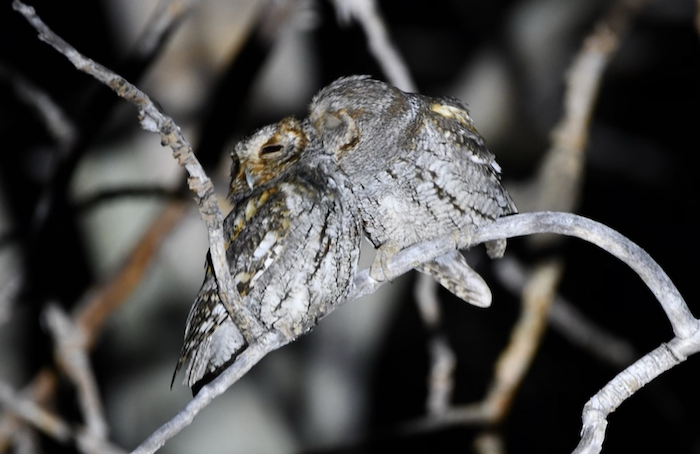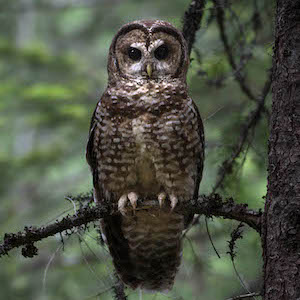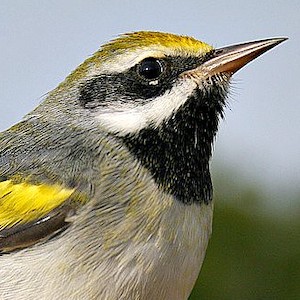Have you ever been flummoxed by a Flammulated Owl? You’re not alone. These tiny owls are tricksters. Their disproportionately large trachea gives them a relatively baritone hoot, allowing them to impersonate a much larger owl species. They are also fickle- one night they will respond to playback, the next night they won’t. Flammulated Owls are only active in complete darkness so you must locate them by ear. But they are deceptive- they will adjust the volume of their hoots if they feel threatened.

A Flammulated Owl shows off its dark eyes. Photo by Julio Mulero/Flickr.
“We often have Flammulated Owls that sound distant (70-100m away) because we can barely hear them,” says Erik Atwell, IBP’s crew leader on the Humboldt-Toiyabe National Forest, “however, we have figured out that the owl is likely in a tree within 20m of us and it is just hooting softly.” Working with this species requires a positive attitude and thankfully Atwell has one. “Their behaviors, paired with their diminutive nature and preference for large pines can make searching for Flammulated Owls a fun challenge,” he comments.
IBP began surveying for Flammulated Owls on the Humboldt-Toiyabe in partnership with the US Forest Service in 2019. The species is classified as a “Sensitive Species” by the Forest Service in Region 4 which includes the Humboldt-Toiyabe, and a “Bird of Concern” by the US Fish and Wildlife Service. Flammulated Owls are threatened by habitat loss and appear to have a low reproductive rate which makes it harder for populations to rebound from setbacks. Most of the research on these owls has been done in the Rocky Mountain region and much less is known about populations in the Sierra Nevada. IBP is working with the Humboldt-Toiyabe National Forest to assess Flammulated Owl populations and how they respond to forest management practices.
Flammulated Owls have flummoxed not only birders, but also taxonomists who are still sorting out exactly which type of owl they are. This species, along with the new-world screech-owls, was originally classified as a member of the genus Otus along with old-world scops owls. But when the screech-owls were reclassified in the genus Megascops, Flammulated Owls were put in their very own genus Psiloscops because they are, for lack of a better term, oddballs.
Along with genetic differences and their oddly low-pitched vocalizations, morphological features- like their dark eyes- differentiate them from other species in the Otus or Megascops genera. They also have longer wings than your typical small owl and lack the comb-like structures on their outermost primaries that dampen the flapping sound in other owls. However there are two bigger peculiarities that set Flammulated Owls apart: their diet and their wandering ways.
A fledgling Flammulated Owl receives a meal of moth from its parent. Video by Erik Atwell.
Unlike the screech-owls, Flammulated Owls are almost entirely insectivorous. They dine on nocturnal insects such as moths, crickets, and beetles. The US has only one other truly insectivorous owl- the Elf Owl in the southwest and its range is mostly in Mexico. Burrowing Owls are also known for eating a lot of insects, but they are omnivorous and seem to prefer small mammals when available.
The Flammulated Owl’s insect-focused diet may be the reason for their wandering ways. These owls are highly migratory, breeding as far north as British Columbia and wintering as far south as Central America. Given that there are few insects active in northern forests during the colder months, arthropod afficionados must head south. Unfortunately, very little is known about Flammulated Owls on their winter range. There are mid-winter records of these birds in southern Mexico, El Salvador and Guatemala, but what habitats they use, and how far the winter range extends, is still mostly unknown. In the future IBP hopes to fit some Flammulated Owls with GPS transmitters so that we can learn more about how best to conserve them across their full annual cycle.
For now we are monitoring them in the eastern Sierra Nevada where they are likely affected by a changing fire regime. Research in Colorado showed that Flammulated Owls were associated with old, open stands of ponderosa pine or Douglas-fir, habitats that were historically maintained by low-intensity ground fires. As fires become more intense, these types of habitats may change. We are also helping the Forest Service understand how forest management practices intended to reduce fire risk may impact, and perhaps even benefit, Flammulated Owls. Though they don’t make it easy, it is an exciting opportunity to work on this fascinating species.






